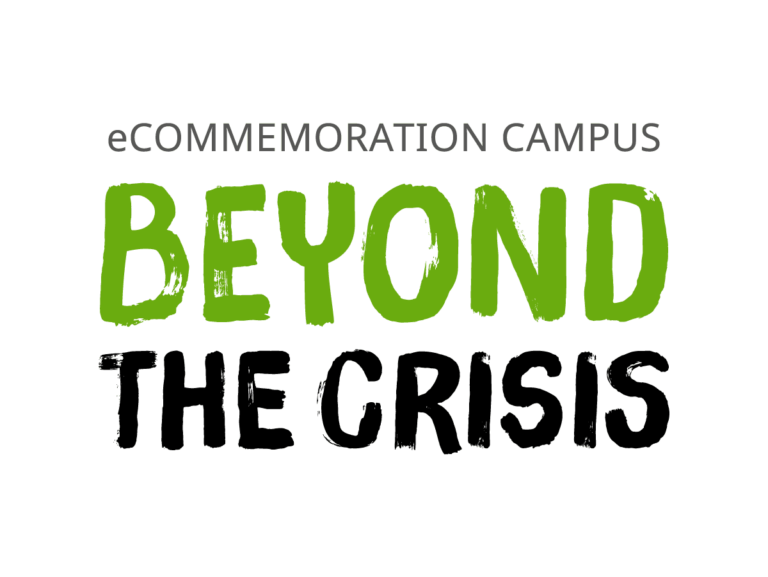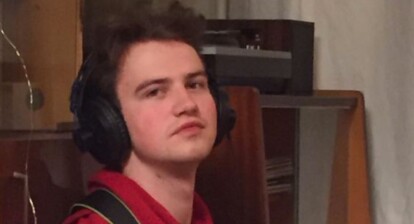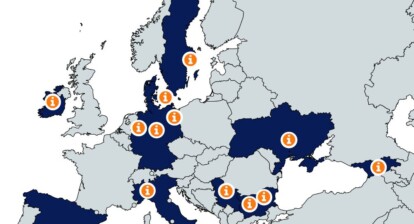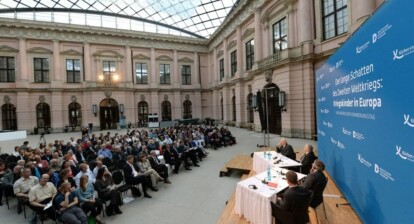The Alberti Family

Location of Jūrmala within Latvia.
On the coast of Gulf of Riga, part of the Baltic sea, there is a sea side town by the name of Jurmala (Jūrmala.) Due to its location it once had its start as a village of fishermen and farmers. A place for families to make their start. Lay their roots. A nurturing, gentle and thoroughly beautiful corner of the world for those who were willing to put in hard work and vision into carving it into a place that could be called home. This story is a story of one of those families. A family of 9. It is a story of making a home, losing the rights to it and eventually new beginnings close by as well as across the seas.
Now, to set the scene, Jurmala is a city by the sea. The air carries the smell of the sea. The sound of the Baltic waves travels into each household. It flows through the windows and every crack of each home at dawn announcing a stormy day ahead. At night the sound almost lovingly puts you to sleep. In the winter the heartbeat of the sea stops. The waves freeze. The seaside becomes one. The coast merges with the Baltic waters all covered in glistering, spotlessly white snow. On some rare, cold nights the ice and snow, with every crystal of their being, reflects the colors of Northern Lights.

The property of Alberti, winter of 1942.
Then there is also the forest, the meadows, the dunes. Latvians have always been and to this day remain people of nature. We feel our forests, our land, the trees. The forests are the deepest shades of green with veins of cool silver birches. The ground is a mix of delicate moss, softest beach sand and green grass. Mild and healing flora flourishing within. It is home. For me and the main hero of this story.
The person this story belongs to was born on January 24, 1942. On the land by the frozen sea. A mere 200 meters from the Baltic waters, just like many Latvians back then, in the sauna of his family home. He was given the name Jānis and inherited the name of Alberts from father. Alongside inheriting the name of his family, he was also given a core to which he keeps to this day. A center of gravity that home and all that comes with it might give one.

Jānis with his parents and sister Erika, 1945
Jānis was the youngest child in the family. He had 2 older sisters and 6 older
brothers. Their family first settled on this piece of land in the 1740’s. They bought it
from a nobleman that owned a lot of land in the area. It is important to note that acquiring
and keeping land in Latvia throughout the country’s history has always been
challenging due to all of the foreign powers trying to gain control and leave their marks.
There have been many moments in history where it has taken an immense amount of
bravery, faith and extremely hard work to hold on to home and the land. Because of this one’s home, land is sacred to any Latvian. 200 years had passed and the family had settled into their property when Jānis was born.

Main house of the Alberti family, 1940’s.
By the time he joined his family they already had a main household, stable, an ice basement, sauna, shed and workshop as well as a small guest house. They had horses, cows, sheep, pigs and chickens. They grew their own crops. Nothing unusual, but every last bit of it created and cared for with love and respect. Modest but not a single part of it taken for granted. And that is how they lived. A family of 10. They would work and live and sustain their home. The kids would share a few bedrooms, sleeping on mattresses made of hay covered with pure white linen sheets, the parents would have the big bedroom with a view of the sea. They would take shifts in the kitchen, preparing food for the family on the heart of the home- the fireplace.

The family horse carriage and the youngest Alberti kids with their father, 1945
During the days they would all work tirelessly to maintain and grow their home. They would plant, harvest, cook, brew, sew, make, repair and sell. The youngest kids, like Jānis, would have to shepherd the cows and the sheep from the first light of every day. He still remembers how the cold grass felt beneath his bare feet in the early mornings, the dew and wind from the sea in his hair. How jealous he felt of his older siblings who got to do more serious chores, especially the brother who got to take the horse and the carriage as well as their harvest and goods and rode to the market to sell them. He would always wait for him to come back in the evening with an empty carriage and a smug smile on his face. The brother came back with the best stories with which he entertained the whole family at the dinner table.
In the summers they would host guests in their guest house from Riga as well as Russia, Poland, Sweden, Germany. Some of the guests were known artists of the time, they liked to stay there and spend their days painting scenic marine pieces. The foaming waves on the soft, white sand, wooden boats and vast fishnets drying on the beach. Pine trees squeaking in Northern winds and meadow flowers bending with the weight of fresh morning dew.
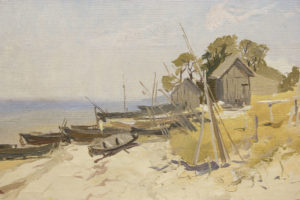
Jurmala, a painting by Eduards Kalnins, 1954.
The parents of Jānis were not rich people, but what they had was theirs. They had given every last ounce of themselves for it, honoring what their family before them had started.
The story of Jānis started in the midst of WWII. He was a child born at wartime. In a country that was the battleground between two armies, Russian and German. The people were made join different fronts and stand against each other. When the fronts would shift they would kill the people for joining the opposing army as if they ever had a choice. The two armies would burn and destroy any farm land when their front lines shifted, so that the opponent wouldn’t find anything but destruction. While this was happening in the country, let’s remember that the Albert family were living 200m from the coast line, in the seaside city of Jūrmala. They were fortunate enough to never be in the crossfire. However, that does not mean that they were left intact.
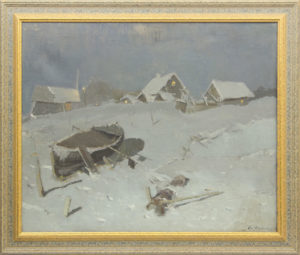
“Jurmala in the winter” a painting by Eduards Kalnins, 1936.
During WWII the oldest siblings of Jānis moved abroad, to Germany and started their new lives there. They found refuge with distant relatives and were quick to settle in. They worked so that they could help the family back home. It was not unusual for people to look for new homes overseas as Latvia had always been a tough place for common people to survive and thrive in. Yet in cases like this the parents and the rest of the family would not consider abandoning their home no matter the struggle.
The war was over. Latvia came out of it under Soviet occupation. The aftermath was beginning. On 25th of September 1948 it was declared by the Soviet authorities that everything that was privately owned now belonged to the country. By nightfall noone in Latvia owned anything anymore. In the days to follow everyone had to start paying rent for being in their homes and using their stables, sheds, saunas. The rent for stables and sheds were almost twice as high as the one for a residential house. That was to make sure people could not afford to sustain themselves anymore. A proletarian vision. They were allowed to keep their farm animals, but a share of everything would always go to the country – 3 pigs for the family, one for the country, for every cow a staggering 200 l of milk were owed to the country. For every 3 stacks of hay, one belonged to the country. With every year to come the toll went higher.

Alberti kids before the nationalisation, dressed in formal attire
The Soviet government would also use this time to house particular people as they pleased. This happened to be the case in the story of the Albert family. Shortly after the nationalisation the government showed up at their doorstep to announce that from now on their other house would be the home to a Russian family and the guest house and the stable would now belong to a gypsy family. When the families arrived they quickly claimed the property as well as other belongings such as food, clothes, firewood of the now struggling family of Alberti, as the government was on their side. The Russian family was soon relocated and the house they occupied was then given to the local fishermen as a place of gathering, then it was home to a movie producer who turned the house into his studio.

Alberti kids after the nationalisation, not being able to afford season appropriateclothing for all children
In the years to follow the nationalisation the family experienced extreme hardship. Financial and emotional. Jānis felt it in the way he was dressed differently at school, they way he would have to miss school in the early months each autumn to help his family with the harvest so that there would be food. In the way he would have to wear the same thin and short clothes all the way through winter as they could not afford anything better anymore. As at home they were struggling. They had lost their ownership and saying in what goes on at home. Their yard, their home, their safe space was now open to everyone to come and live in or to take whatever they pleased. On top of that they had to pay a toll for everything they owned and did. One winter the pigs killed a chicken and the father had to write a letter asking the government for understanding and reducing the egg fee.
Throughout this time of loss and adjustment they stayed together as a loving family. They lived off the bare minimum but they still lived on their land. Land that they had nurtured and maintained with their bare hands. They patiently followed the government’s requests yet their hearts were aching. They were aching out of helplessness of the situation, they ached for the unknown. Not knowing how to make it through the harsh winters, not knowing when and if they would be asked to leave any day, they ached for every person who was placed in their home by the government and had more ownership of their home then they did as they never knew who these people would turn out to be.
When the denationalisation came it took an additional 15 years of bargaining and convincing the authorities to give back their property. The family of Jānis were one of the lucky ones to recover their land. It was broken and split, but part of it was theirs once again. What was left of their home was not enough for a family of so many, and in these years they all had grown. Even Jānis was not a little boy anymore. Eventually they scattered across the city by the sea. Not too far from home. They never left the sound of the waves, the smell of the sea and pine trees. The Albert brothers and sisters scattered along the coast but their home remained as a reminder of the hardship and love through it. They worked and are still working till this day to honor the legacy as well as the hard work of their parents by taking care of the shrunken piece of land they recovered during the denationalisation, and by turning houses into warm and safe homes for their own families, to telling the story and teaching the value.
As a matter of fact Jānis grew up to be an architect. He has helped countless people find and create their homes. Places to lay their roots and feel safe. Their space. For he has learned the value, beauty of it as well as felt the pain and struggle of losing it.

The Alberti family in 2015 at a family reunion on the property. Jānis, my grandfather, is sitting in the middle (front row) wearing a striped shirt. He brings us together.
Jānis is my grandfather. He tells me stories of his family and how they lived. There is no sorrow in his stories. His stories, this being one of them, are stories of deep appreciation, faith and dedication. The love of a family that is one safe space, home that can not be taken away. It is also a story of new beginnings, not too far away, with respect to the past. Stories that live on in different shapes and forms, places, homes.

